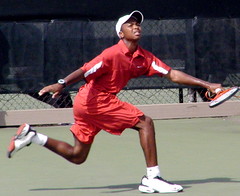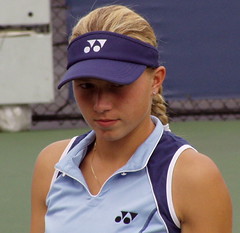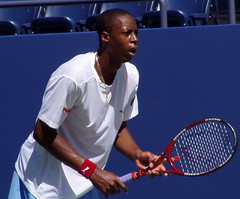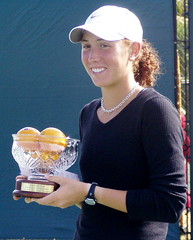Eight Most Intriguing Questions in Junior Tennis for 2005
©Colette Lewis 2005
Can Donald Young continue his improvement?

After a largely disappointing summer that saw Young lose in the round of 32 at Kalamazoo, the first round at the US Junior Open and the second round to fellow US fifteen-year-old Dennis Lajola at the ITF Grade 1 event in Kentucky, he got back on track this fall and early winter, winning the North American Closed, making the semifinals at the Eddie Herr, the finals at the Orange Bowl, and winning the Grade A Casablanca Cup. A long way from physically mature, Young can still be overpowered on occasion, but he already has developed a knack for winning and a court sense and creativity that justify the considerable IMG-fueled hype.
Which 15-year-old female star will have the biggest impact in 2005?

Czech star Nicole Vaidisova has served notice with two WTA wins last year but the Netherlands’ Michaella Krajicek, half-sister to Wimbledon champion Richard, (pictured above) may outshine her. Krajicek finished 2004 with the ITF’s top ranking without playing any events after winning the US Open junior title, and helped the Dutch team reach its first main draw of the Hopman Cup in nine years.
Will Andrew Murray survive the British media barrage and win a Wimbledon junior title?
After his US Open junior title in September, the 17-year-old native of Scotland has become a press darling in Great Britain, despite the fact he trains at the Sanchez-Casal Academy in Spain. As a survivor of the Dunblane school massacre in 1996, Murray has been asked every conceivable question about the tragedy in post match news conferences, and he has never been anything but thoughtful, gracious and forthright. But the tabloids’ gloves will likely come off this summer when he returns to Wimbledon as a heavy favorite to win the tournament he doesn’t much care for, preferring New York’s pandemonium to the All-England’s gentility. And should Henman exit the main event before the junior tournament begins…
Can anyone win the Junior Grand Slam?

After Roger Federer’s year in 2004, his chance for a Grand Slam is hot topic one for 2005. For Gael Monfils, the French junior who won the first three junior slams in 2004 before losing at Flushing Meadow, that question is now moot, as he loses his junior eligibility in 2005. The global growth of tennis continues to add to its depth, so it seems increasingly unlikely that a dominant player will emerge. But it must be noted that Brendan Evans and Scott Oudsema of the US won three of the four 2004 Grand Slam doubles titles, so the possibility is tantalizing.
Will the Russian women keep coming?
There is no sign of the talent pool draining, as two of the four girls 18 semifinals at the 2004 Orange Bowl were Russian and two Muscovites met for the Eddie Herr 14s title last month. But this is definitely a sex specific revolution, as Russia has no male in the top 64 in the ITF junior rankings.
Can Jessica Kirkland defy the ever younger demographic of women’s tennis and become a force on the tour at the ripe old age of 17?

After the past few months, it would be dangerous to think otherwise. A finalist at the US Open juniors, and winner of the Grade 1 Winter International and Grade A Orange Bowl last month, Kirkland has won 16 of her last 17 matches on the ITF junior circuit and beat the number one seed in the qualifying tournament in Auckland, the WTA’s first event of 2005. In an era when a WTA match features as many tears as grunts, Kirkland’s composure sets her apart, and though her game may lack variety, a top-notch forehand and the consistency of a metronome make her a player no one will want to face at the next level.
Will the United States continue to dominate the boys ITF junior rankings?
It WAS surprising when all four of the 18s semifinalists at the 2004 Orange Bowl were from the US, but it was just an exclamation point to a sentence that began last year. Boys from the US won two of the five Grade A singles titles in 2004, and in the Grand Slams, the US had two quarterfinalists at the Australian, two semifinalists and a finalist at Roland Garros, a semifinalist at Wimbledon and two more quarterfinalists at the US Open. In the first Grade A event of 2005, the Casablanca Cup, four of the quarterfinalists were fifteen-year-old Americans. The 2004 year end ITF rankings featured seven Americans in the top 32. No other country had more than three.
Cyclical though these things may be, the USTA’s junior program is attracting great athletes and providing them with coaching, training and travel opportunities, and, perhaps most importantly, a critical mass of other American juniors to compete against. Andy Roddick has given American men’s tennis a contemporary face and the Williams sisters and USTA diversity programs have changed the perceptions of the game’s relevance to all Americans. That said, the storyline mirrors the Russians, but with genders reversed. The US junior girls were MIA until Kirkland emerged at the US Open, and she hasn’t been pushed by any of her countrywomen.
Will “The Zoo” do for junior tennis what “Spellbound” did for spelling bees and “Hoop Dreams” did for high school basketball?
Jim Courier has embarked on a documentary film project --following the top US junior boys throughout 2005, culminating with the Nationals in Kalamazoo in August. Courier’s movie is off to a rousing start, as filming began at the 2004 Orange Bowl with Timothy Neilly, one of Courier’s storyline choices, winning his first major ITF title (see story in Dec. archive). The microphones and cameras didn’t faze Neilly, giving Courier, a finalist at Kalamazoo in 1987, a persuasive selling point for the next junior he selects to film.









0 comments:
Post a Comment